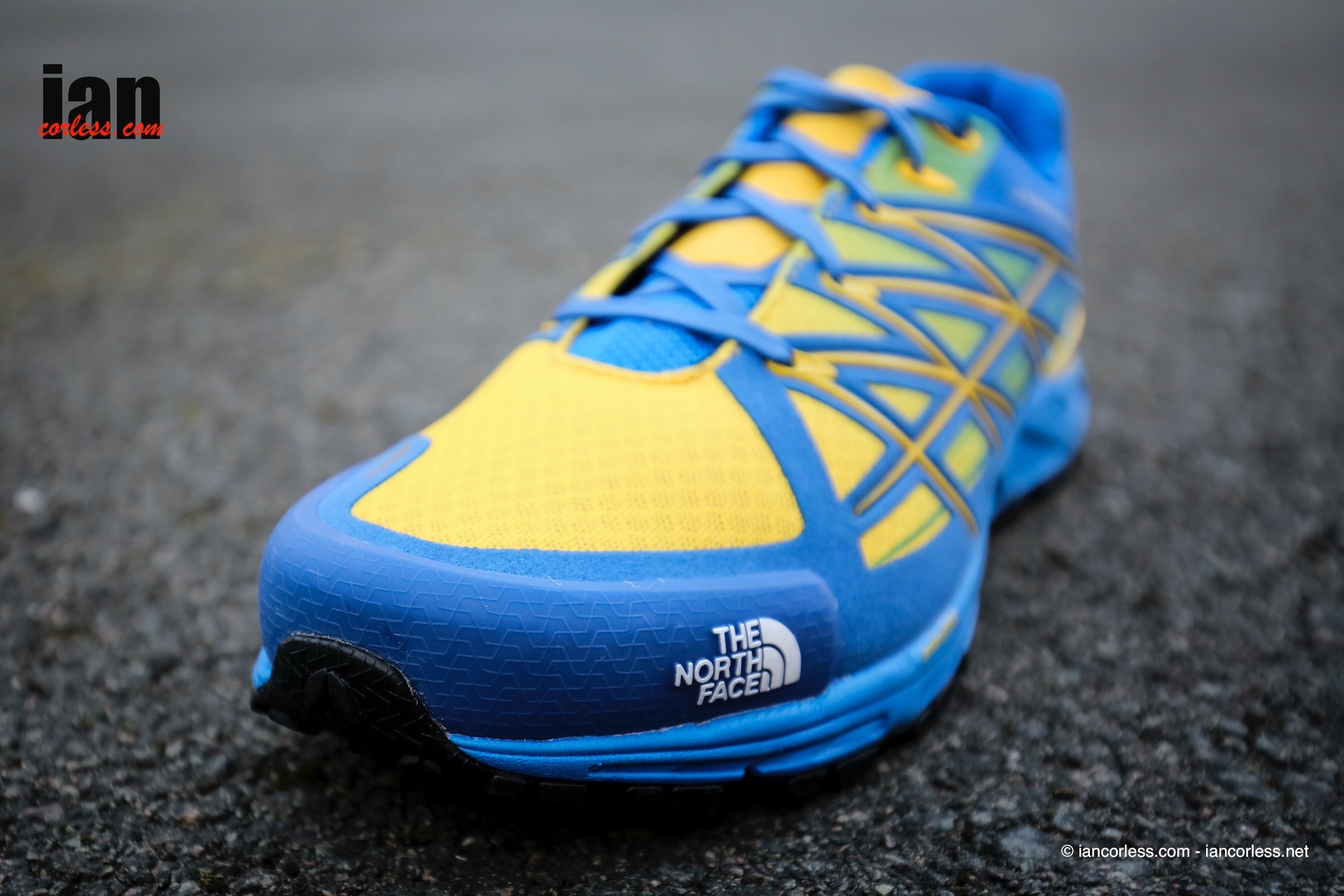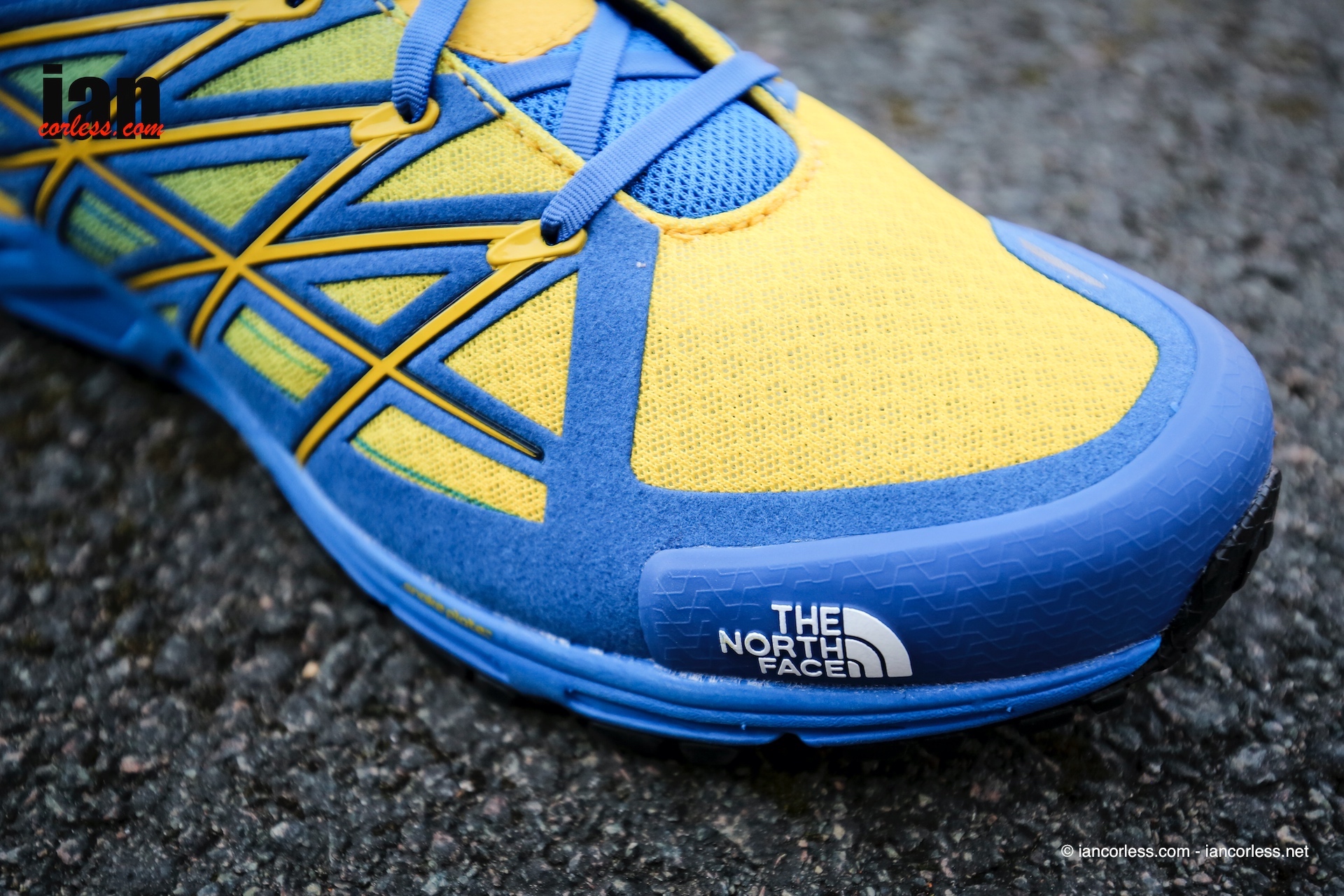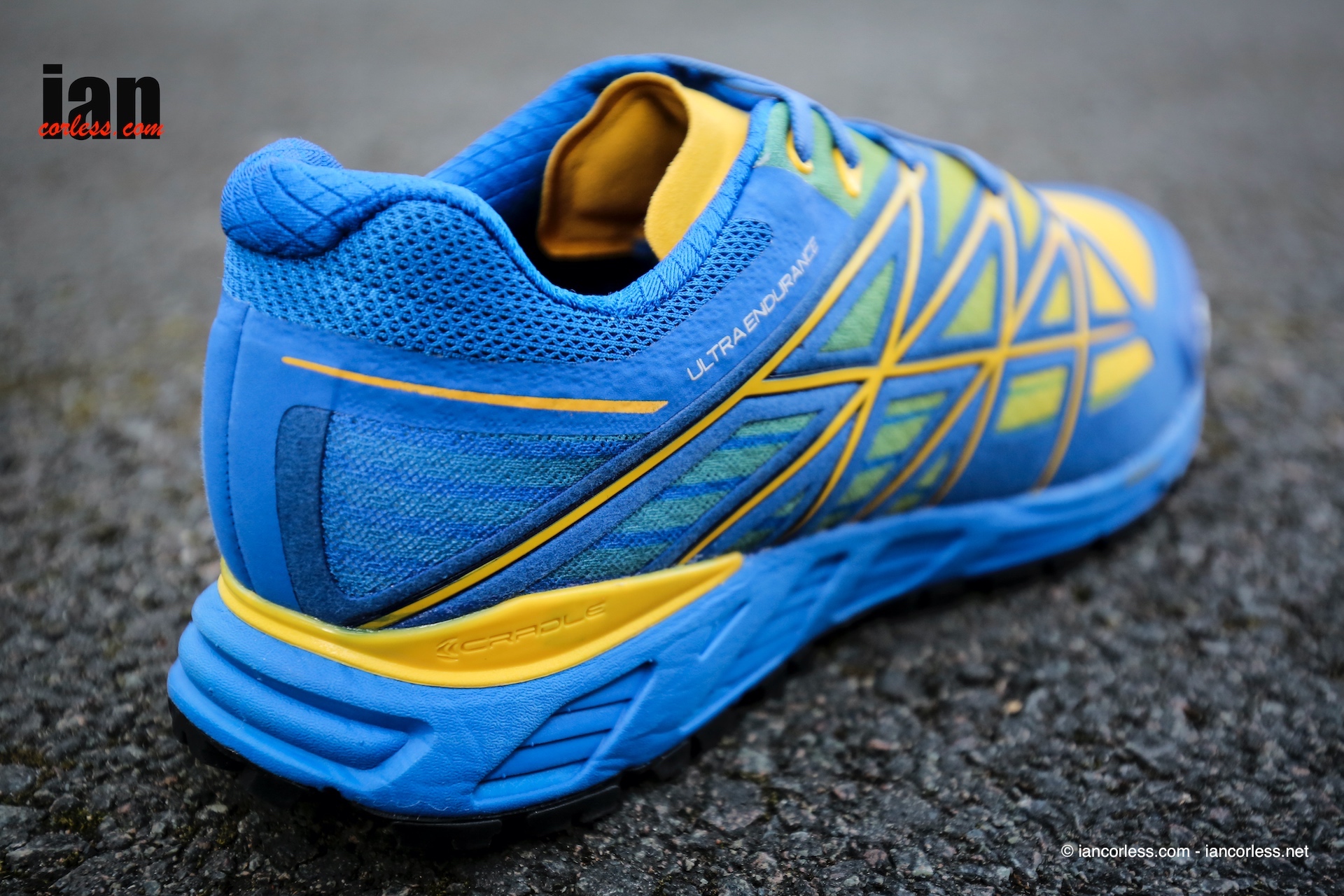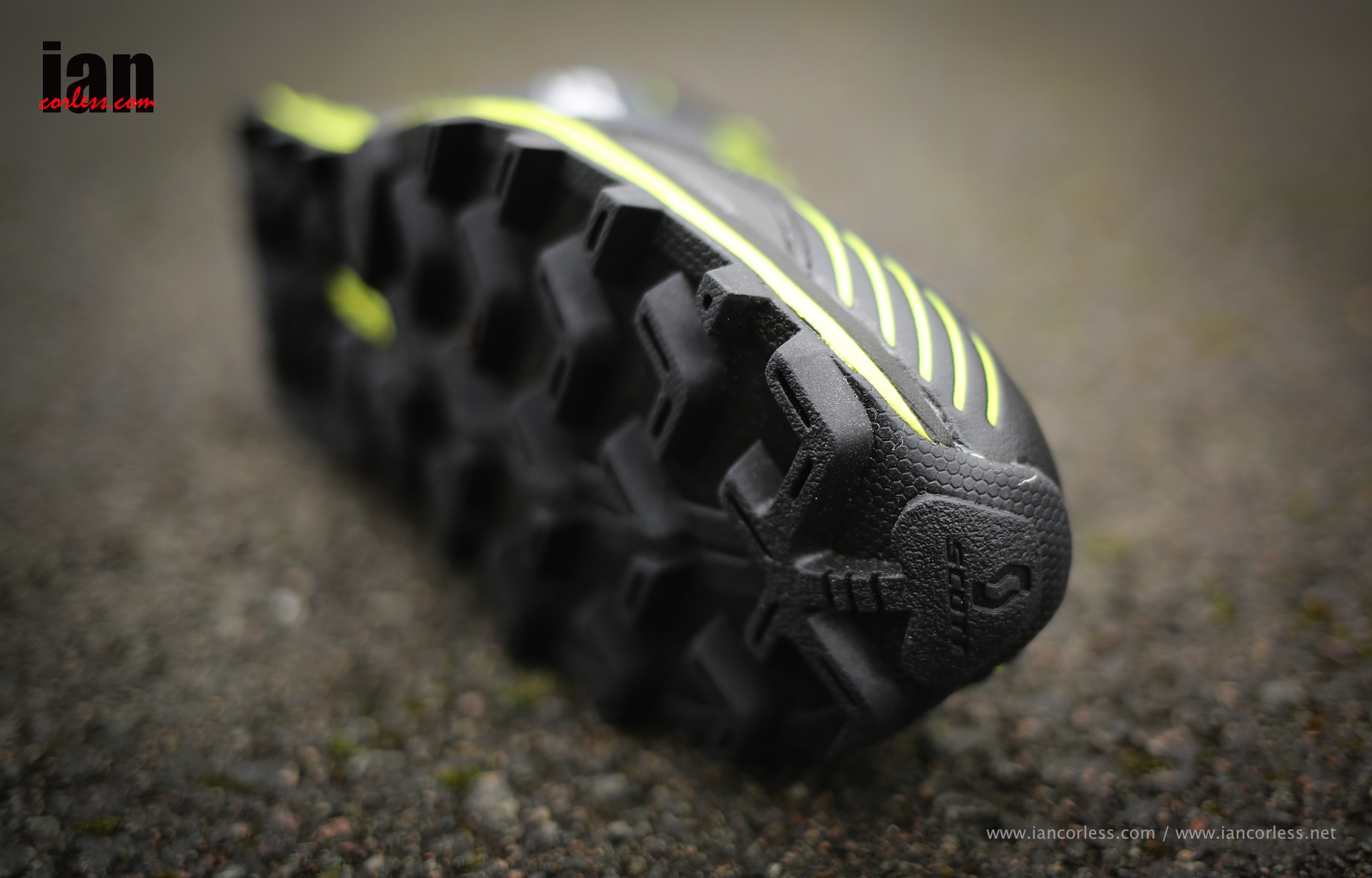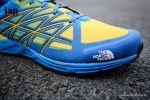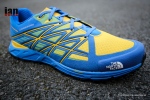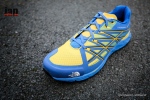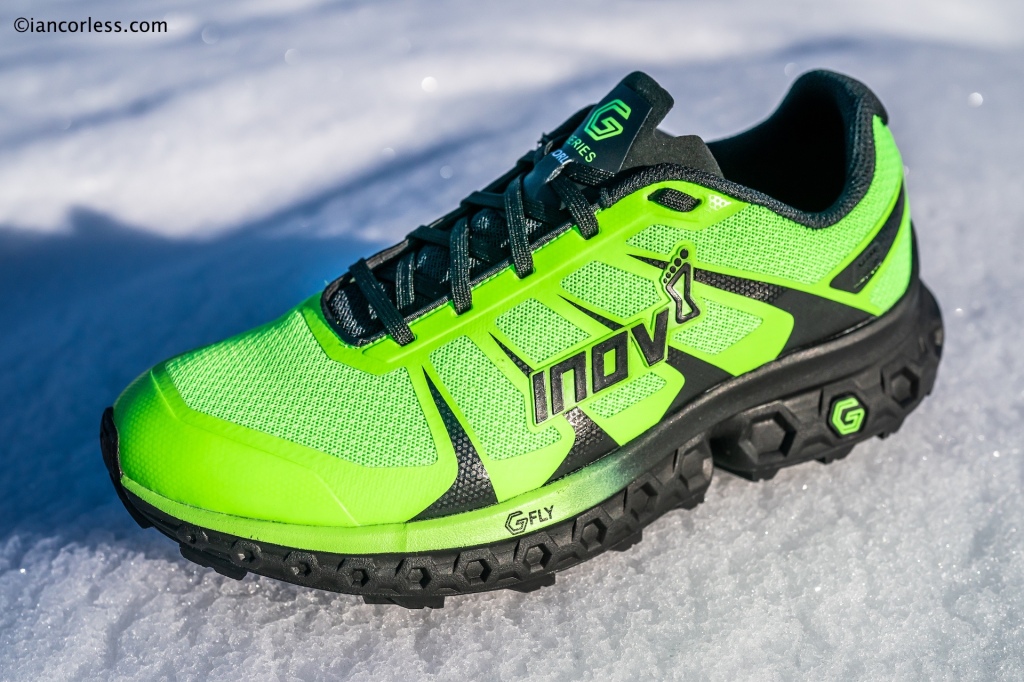
inov-8 introduce the TRAILFLY ULTRA G300 MAX, the first ever shoe to feature Graphene enhanced foam. Coupled with other new technologies, inov-8 say, “the TRAILFLY ULTRA G300 MAX will be truly unique in the marketplace.”
Let’s deep dive into a first look and appreciation of what on first looks, may look like a Terraultra G270 on steroids.
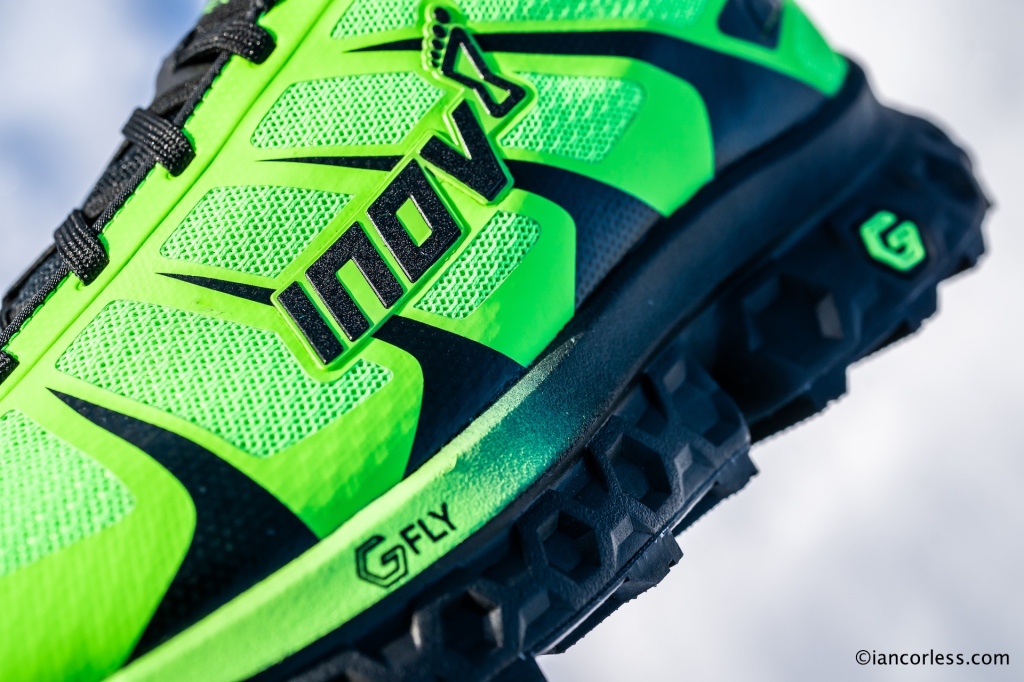
Quite simply, the TRAILFLY ULTRA G 300 MAX is the most cushioned shoe ever produced by inov-8 and that alone is a huge departure for the brand who have a reputation for grip and a ‘feel for the ground’ approach to run shoes. I will say immediately, this is going to be a ‘Marmite’ shoe for the brand, with many loving it, and equally, many hating it!
Having pioneered the use of Graphene for many years in outsoles, inov-8 now extend this technology to the foam, and based on research, this can provide up to 25% greater energy return, “Featuring the world’s first Graphene-enhanced foam, called G-FLY”.
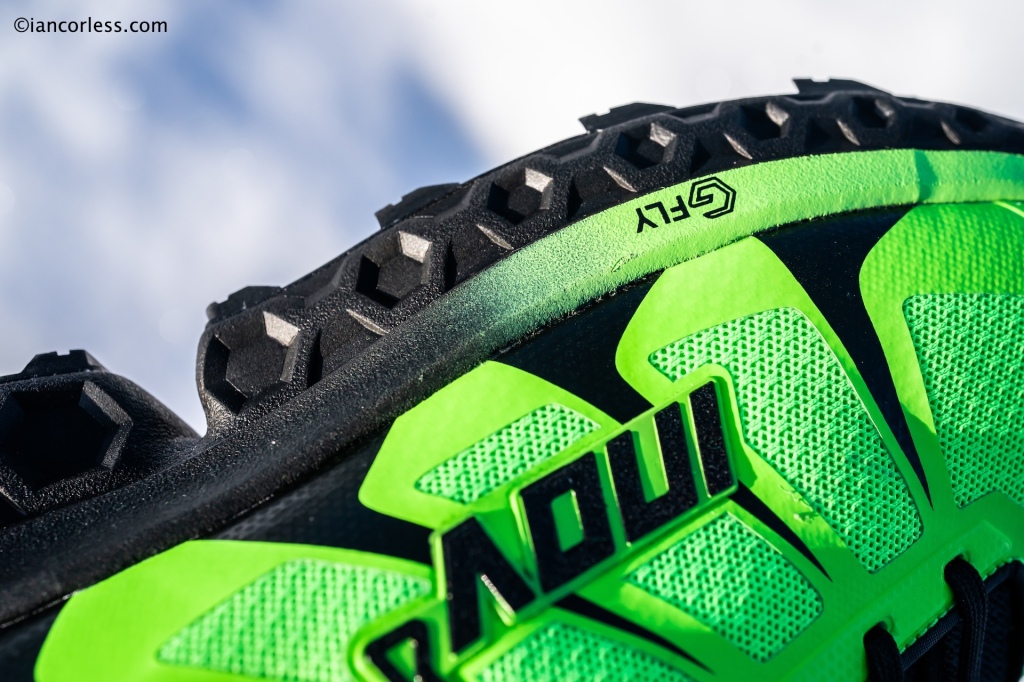
As inov-8 say, “Forged in the fells and mountains of the Lake District in 2003, we are a footwear, clothing and equipment brand for committed trail and off-road runners, adventure-seeking hikers and fitness athletes who push boundaries and stretch limits.”
In recent years, that forged in the fells has been developed and rightly so. inov-8 now offer a variety of shoes that encompass a multitude of sports, distances and surfaces. In summary, fell, mountain, trail, park, OCR, orienteering, road, swim run and yes, even CrossFit, training, weightlifting and hiking. The recent success of the Terraultra G260 and now G270 has no doubt allowed inov-8 to look farther afield and this, I am sure, fueled by customers asking for, “…a more cushioned shoe with sweet-spot drop to facilitate comfort over longer running,” has resulted in the TRAILFLY ULTRA G 300 MAX.
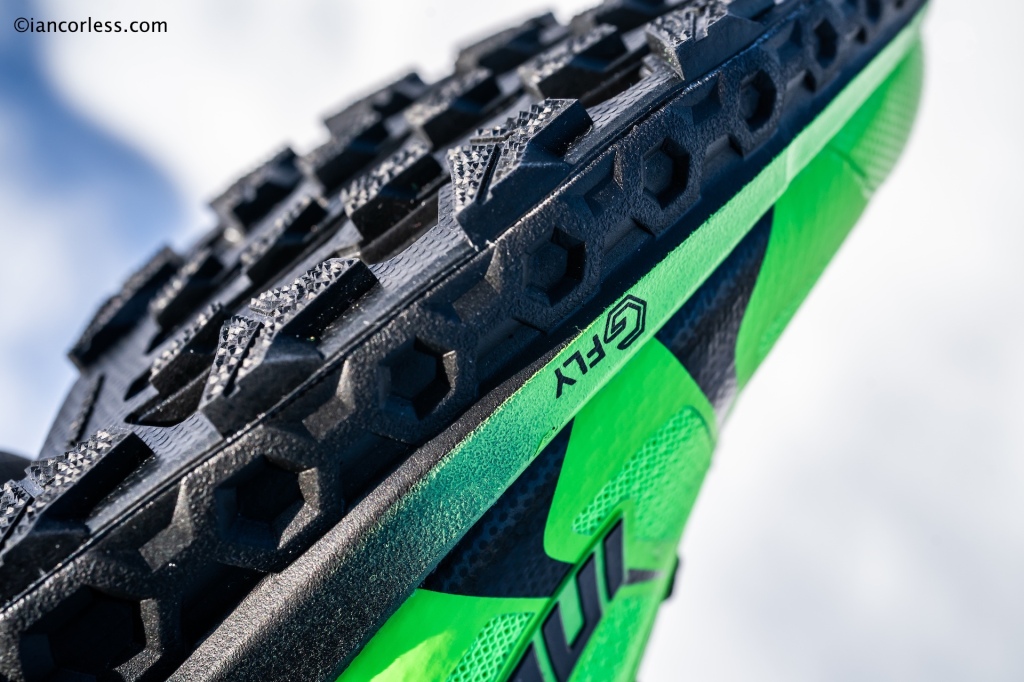
Cushioning will immediately divide an audience and I could debate and debate the pros and cons all day if cushioning is a benefit or not. To clarify, Hoka One One was created in 2009 and up until 2012 I was pretty much using Hoka for all my runs, I had the original Mafate, and Bondi B and I was the first person to bring them in to the UK and sell them… So, I have history with cushioning and I still use cushioned shoes, occasionally. However, in 2012, with chronic knee pain and issues, I defected, stripped myself back to minimal and learnt to run again. Cushioning, or too much cushioning, was not good for me and particularly all the time. I wrote an article HERE that still resonates.
” People actually land softer when they have less cushioning,” says Irene S. Davis, Ph.D., PT, a professor in the Department of Physical Medicine and Rehabilitation at Harvard Medical School and director of the Spaulding National Running Center. “Cushioning actually lulls you into thinking you can slam your foot into the ground.”
With the growth of ‘cushioned’ brands, more and more research has been done and I can find documentation that provides 50/50 information on the benefits and lack of benefits of cushioning. In summary, I feel the following (for me) rings true: A more minimal shoe allows me to feel the ground, react with it and adjust my forces and trajectory based on real time feedback. When in a cushioned shoe, I struggled for that feedback and therefore hit the ground harder to get the information I need. On technical terrain, cushioning and stack height causes problems for me, I am less stable and have reduced and impaired information.
“Since recent research has shown that running in maximalist shoes alleviates pressure from the feet, these shoes can be incredibly helpful to runners who struggle with foot injuries such as metatarsal stress fractures, plantar fasciitis, or heel pad atrophy. But runners with knee issues might want to avoid maximalist shoes, as knee loads might be higher… On the opposite end of the spectrum, minimalist shoes increase loads on the 4th and 5th metatarsals, plantar fascia, and Achilles tendon, but they reduce loads on the knee.” – Richard Willy, Ph.D
What works for one, does not work for another and let’s face it, max cushioned shoes are selling in high numbers all over the world. If cushioning works for you, great! inov-8 have addressed this issue and maybe, just maybe, they will bring new eyes and a new approach to the ‘max’ debate.
“Maximizing innovation, underfoot agility & flex this new shoe from inov-8 is packed with energy return zip and also boasts Graphene-Grip rubber and the ADAPTER-FIT upper. Designed specifically for ultra and long-distance running over trails, including technical terrain.”
inov-8
THE SHOE
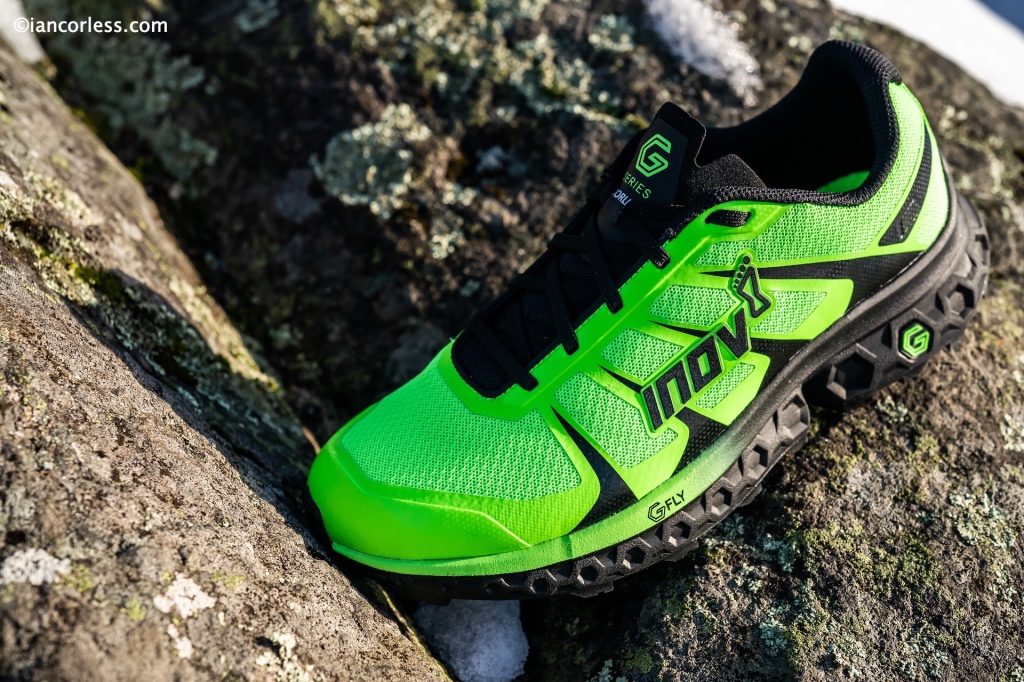
I said Terraultra G270 on steroids and that is pretty much what the TRAILFLY ULTRA G 300 MAX looks like. If you don’t see them from the side, you could easily be fooled in to thinking it was the G270 – there are differences in the look and overlays, but in principle they look similar. However, that side profile makes the jaw drop a little… There is A LOT of cushioning and that is exasperated with the hexagonal shapes and at the rear, a green ‘G’ boldly emphasizes the use of Graphene.
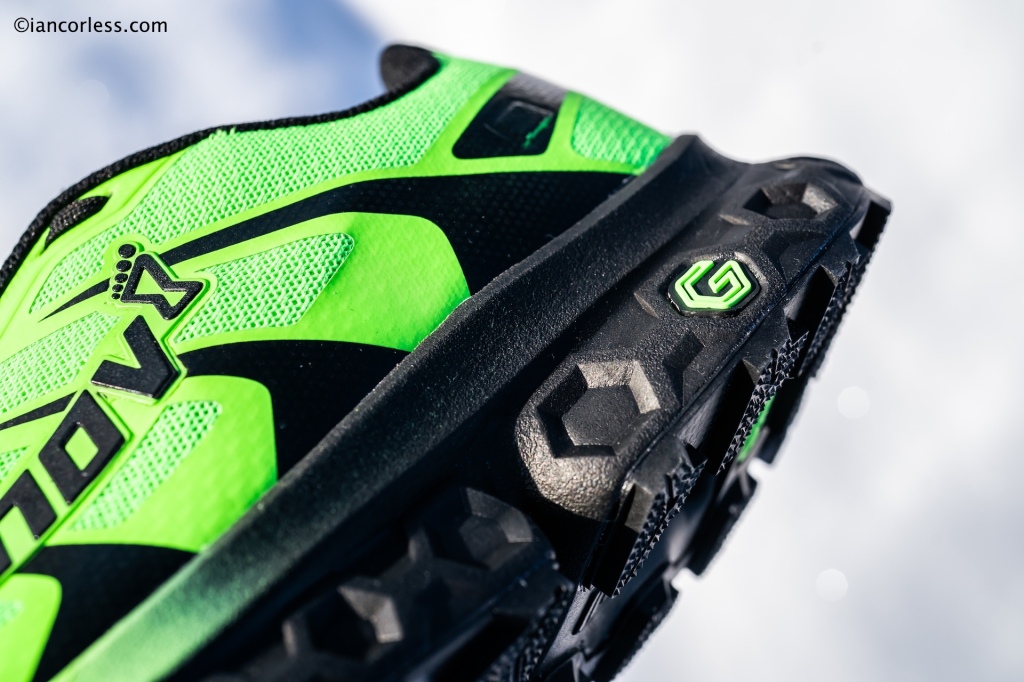
For perspective, the zero drop G270 has 12mm/ 12mm front and rear cushioning, the Trailroc G280 12/20 and the Trail Talon 290 v2 11/19. The latter two shoes with an 8mm drop. The TRAILFLY ULTRA G 300 MAX has a 6mm drop and 24mm/ 30mm front/rear cushioning – that is huge! Especially if you add the 6mm ‘Boomerang’ insole making the overall cushioned package 30/36mm. Wow!

New for this shoe, the cushioning has been enhanced with Graphene, inov-8 say, “Graphene-enhanced G-FLY cushioned foam is more resistant to wear. It retains its thickness and optimum levels of snappy energy return for longer, helping runners feel faster and fresher over greater distances. Incredible energy return AND increased durability, no compromise.” The Powerflow Max used in the G270 has been developed once again and now, in this shoe with G-FLY, apparently gives 10-25% more energy return…
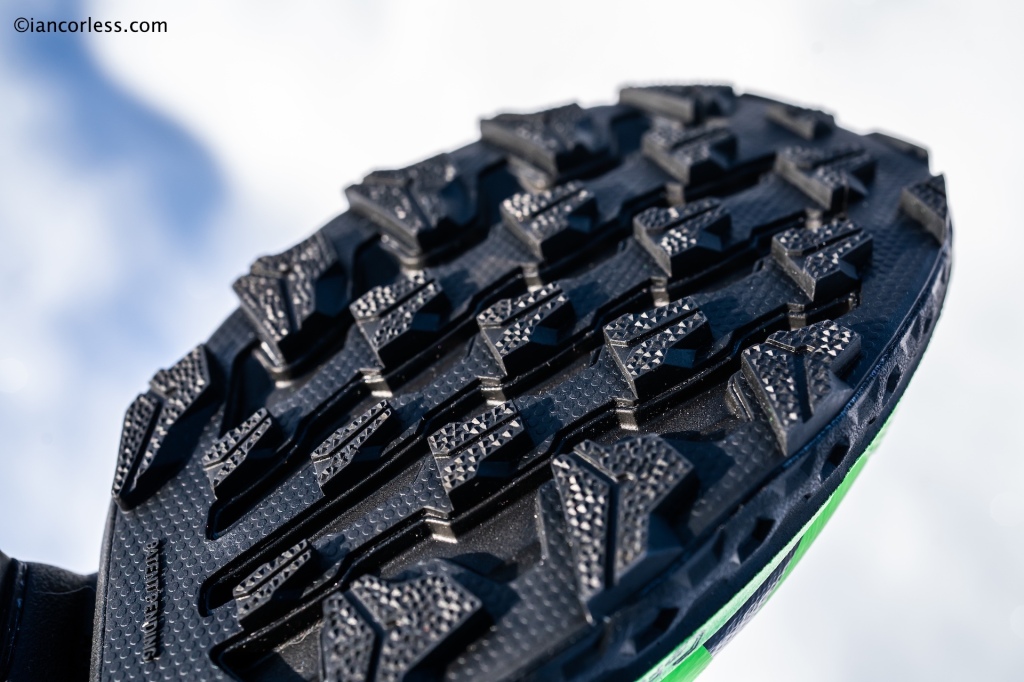
Turning the shoe over the outsole is considerably and notably different. The 4mm Graphene Grip lugs, of which there are 35, look pretty standard, particularly in comparison to the G270 but are well spaced to reduce debris hold. The Graphene grip is excellent and has received praise. However, two notable things stand out. No ‘Meta-Flex’ at the front and in the latter third of the shoe there is a cutaway, splitting the outsole, this is called ‘Adapter-Flex.’
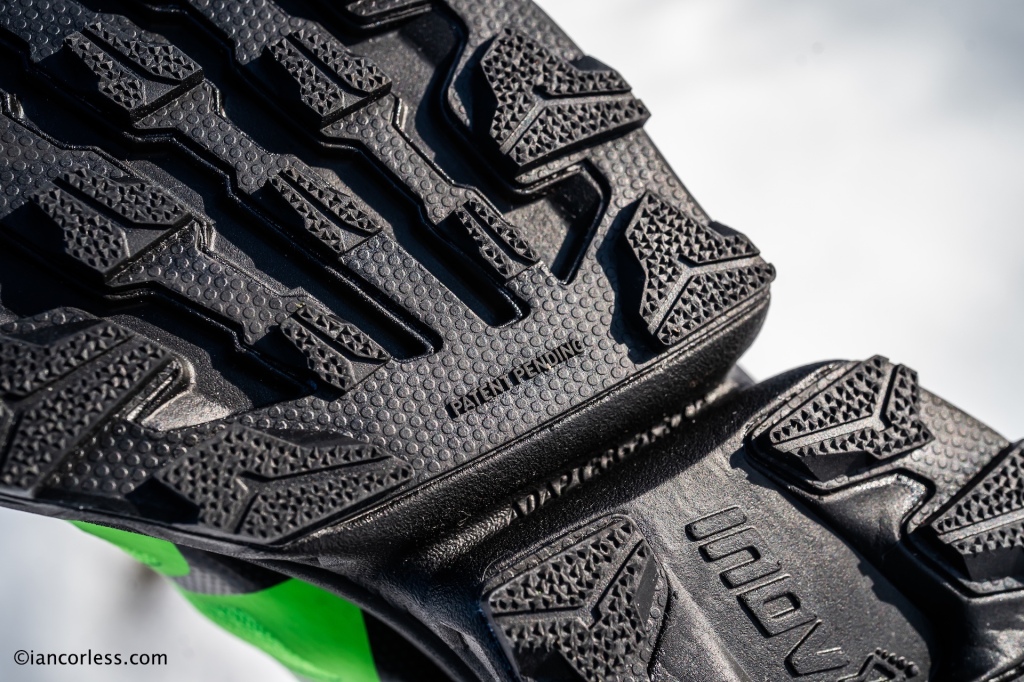
I have to say, I was initially perplexed with the lack of Meta-Flex but then on inspection of the outsole I noticed that there are 4 cutaways that run vertically. Equally, the cutaway had me holding my chin and a ‘?’ hanging over my head. However, when I held the shoe and twisted it, all became clear. These two features are designed to re-think how a cushioned shoe works, and, in my opinion, they are designed to compensate for the stack height and add more flex (left to right) when running on uneven terrain. Quite simply, if you can visualize, as the foot hits the ground, say landing on a rock, the rear of the foot could hold still and secure, the flex allowing the front to go right or left. This in principle, should help make a more cushioned/ higher stack shoe adaptable for technical terrain?

A Boomerang insole adds to the cushioning with 6mm depth and gives, “40% greater energy rebound,” according to inov-8. In principle, the foam structure retains more energy than ever before with TPU beads compressing and then springing back to release energy to help propel you forward.
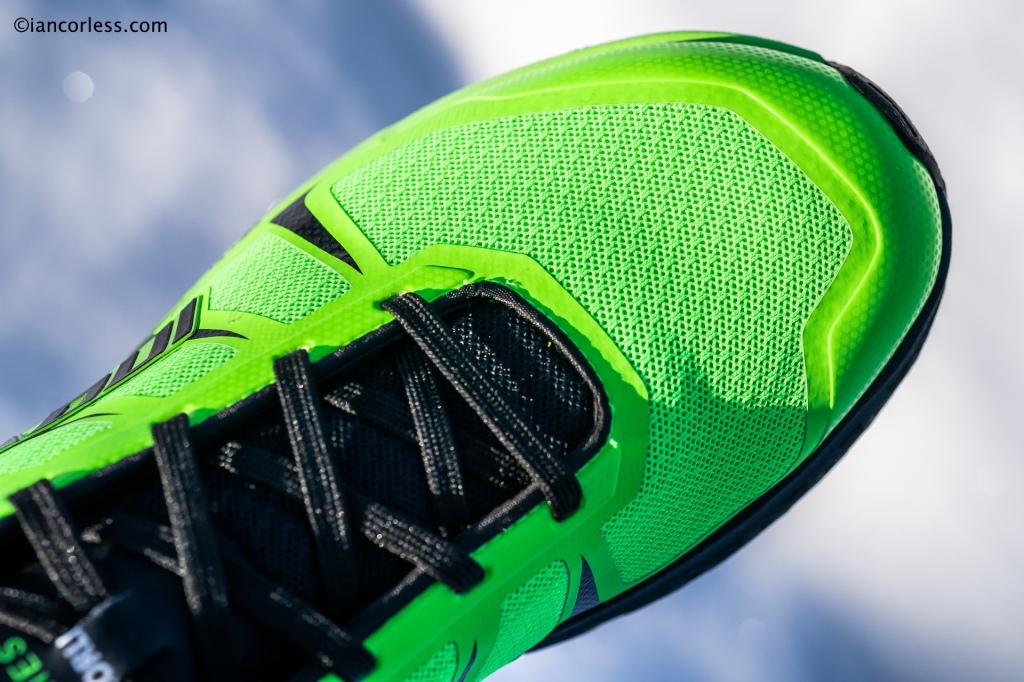
The upper, as mentioned, carries much of the G270 but it is not the same. The toe box is different, and the overlays start farther back on the shoe leaving the toe area on the TRAILFLY ULTRA G 300 MAX open. It’s a lightweight upper and breathable.
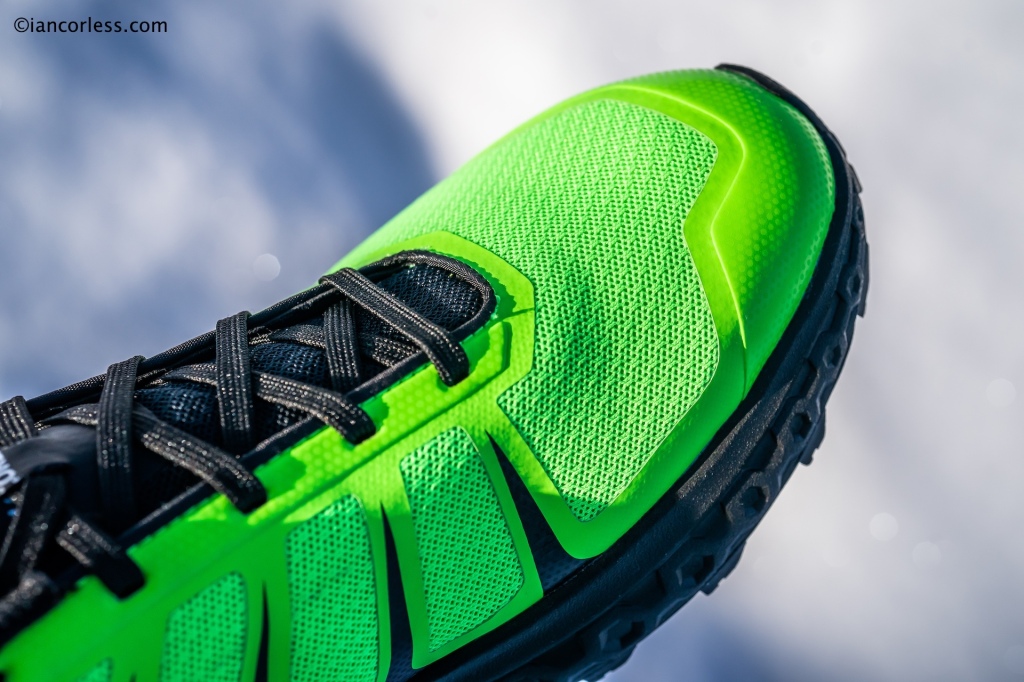
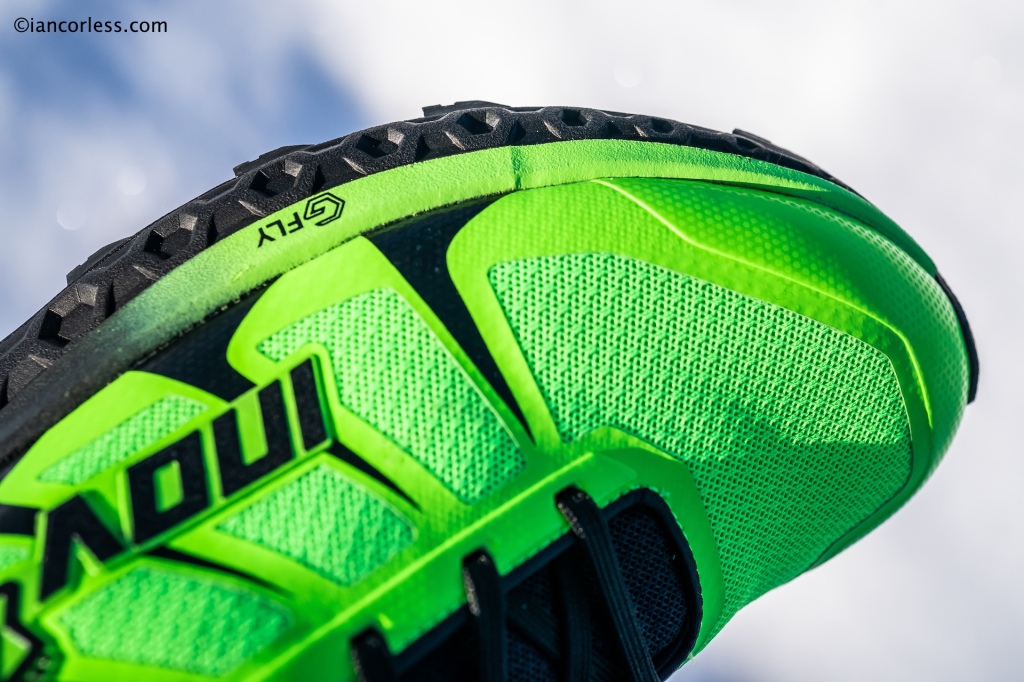
The lacing system is rock-solid and holds the foot perfectly particularly (Adapter-Fit) on the instep and navicular bone. It’s not a sock-like fit but the tongue is attached to the upper by elastic. The toe box is wide, listed as 5 on the inov-8 scale which is the widest that they do. On a personal note, the G270 is also a 5 fit but for me, they feel just a little wider than the TRAILFLY ULTRA G 300 MAX. There is the gaiter attachment on the rear of the shoe, always a nice touch from inov-8.
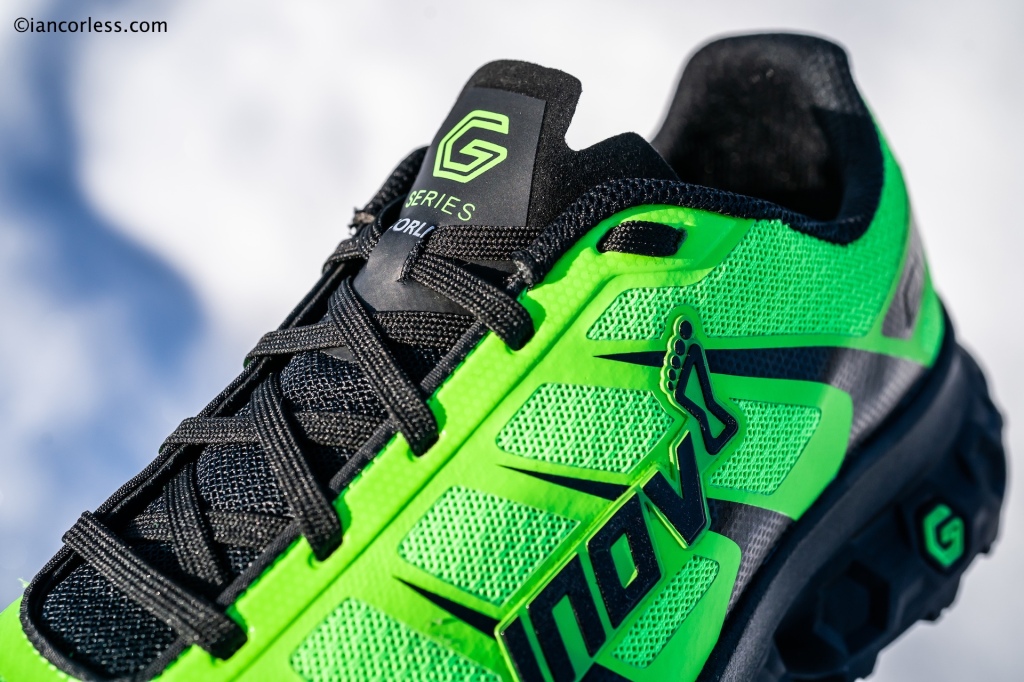
Fit is true to size, my EU44/ UK9.5 is certainly in line and comparable with all other inov-8 shoes and other brands.
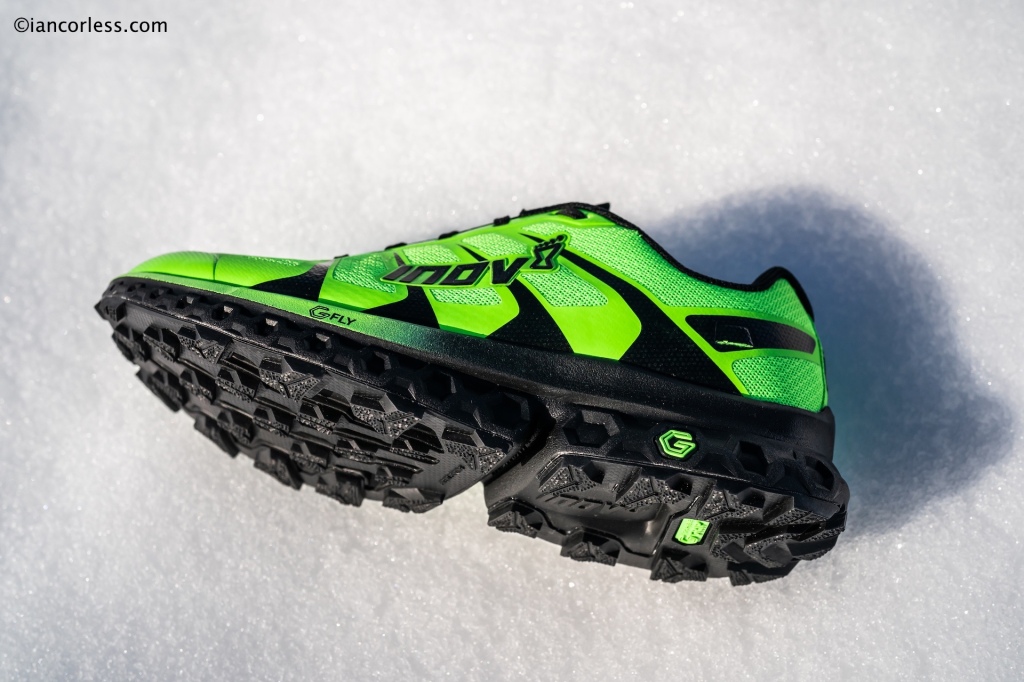
Weight unfortunately for me is disappointing. The shoe is called a G300, ‘300’ referring the weight, but this is an ‘average’ weight and for perspective, a UK7 weighs 318g and my UK9.5 382g. Compare this to the new cushioned ULTRA shoe from VJ Sport which are 100g per shoe lighter… I really don’t understand how inov-8 think this weight is ok?
IN USE
The Boomerang insole immediately gives a nice feel when you slide your foot in the shoe, you can feel compression just by adding body weight. I had anticipated a ‘bounce’ feel from the midsole but that was less obvious. The stack height was immediately noticeable, and I have to say, it felt weird.
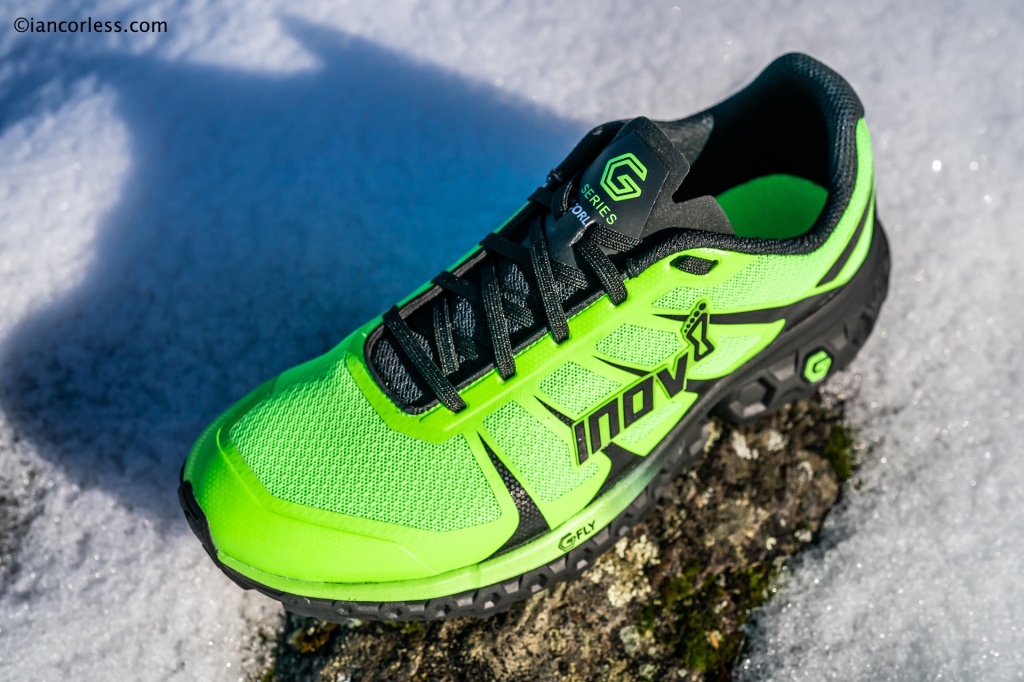
Lacing the shoes up feels great and the combination of elasticated tongue, lace placement and fit really does hold the instep in a very secure and confident way. There are additional eyelets for lock-lacing or similar if required.
The heel box is well padded and shaped and does exactly what you would want and expect – holds firm and comfortable, especially when going uphill.
The toe box is wide and for me allows toe splay. A 5 fit on the inov-8 scale they do feel just a little narrower than a G270, but it is marginal.
For me, there feels a little arch support, it is really minor, but there does feel just a little more support over other inov-8 models. On closer inspection, the support does coincide with the cutaway from the ‘Adapter-Flex’, and this is maybe what I feel?
They feel big! And they are.
They feel heavy! And they are.

Initial walking around made me feel very stable with a big wide (and high) base beneath me. I most certainly could feel the cushioning beneath me, but I wouldn’t say I felt ‘cushioned?’ Difficult to explain, but the shoe was much firmer than I anticipated and that, I have to say, was a disappointment.
ROAD
My first run was intentionally on road, 21km. I wanted to get a true feeling of the cushioning, the ride and how the TRAILFLY ULTRA G 300 MAX handled a consistent and hard terrain. The first 3-5km was all about just getting a ‘feel’ for the shoe and the changes such a high stack brings in comparison to my day-to-day shoes. The 6mm drop and an ideal middle ground, particularly for a shoe designed for longer distances.
With the initial adapting/ adjusting phase done I settled and just tried to run as normal. I have to say, I always felt conscious of the shoe, its size did bother me.
I am a mid-foot runner and the TRAILFLY ULTRA G 300 MAX kept pulling me towards heel striking, it felt as though the heel was too large/ heavy and therefore getting in the way. Somehow it was adjusting my run technique. Over the 21km I tried hard to keep good form but if I drifted off concentration, I found the heel.
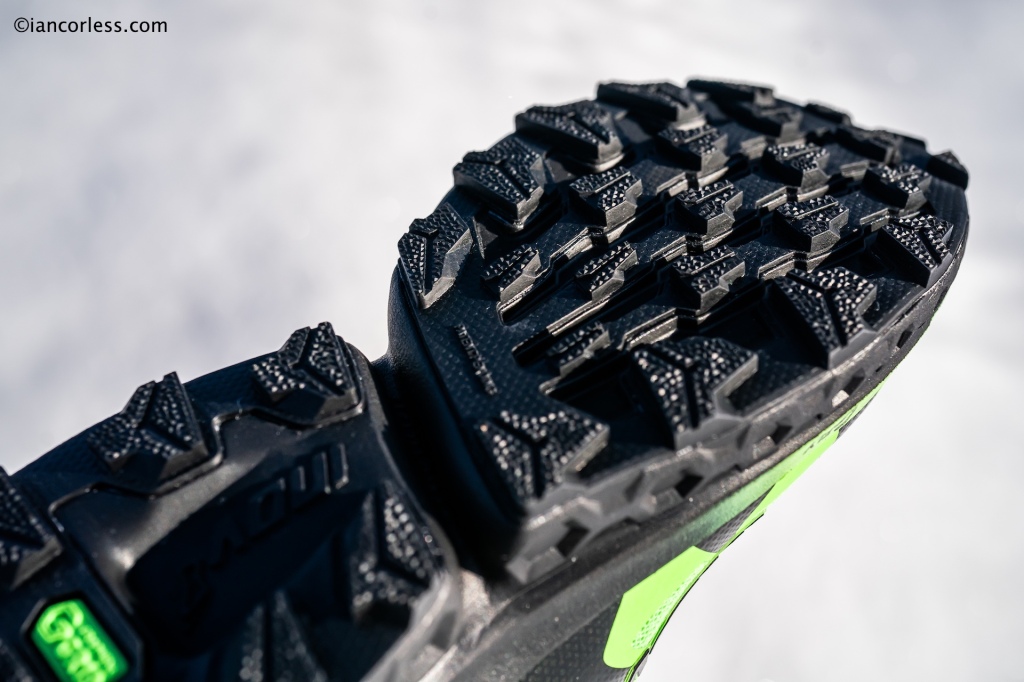
Cushioning was far firmer than I expected, and I found the propulsive phase missing with flex behind the toes a little compromised. I felt flat. As I made contact with the ground, no matter how I tried to roll forward and get the propulsion, I found that I was fighting the shoe. It felt at all times I was really having to work hard to get a return – the shoe was giving me nothing for free! The Graphene may enhance durability and reduce compression with repeated foot strikes, but does it also make for a less responsive and bouncy feel?
Downhill was super, a big wide cushioned heel made for Tigger like happiness.
In the latter stages of the first run, I was feeling over tired and without doubt, the 382g of each shoe was contributing to the fatigue. This wasn’t a fake feeling or the mind playing tricks, the route and my feel on the route is a constant for shoe testing so that I can really notice differences in shoes and their feel. For perspective, a recent shoe test of another cushioned shoe, albeit not as cushioned as the TRAILFLY ULTRA G 300 MAX had each shoe at over 100g lighter. To clarify, my cadence in the inov-8 was 164 avg, in the other shoe, 179 avg. That is huge and I felt it. I say it again, this shoe is way too heavy!
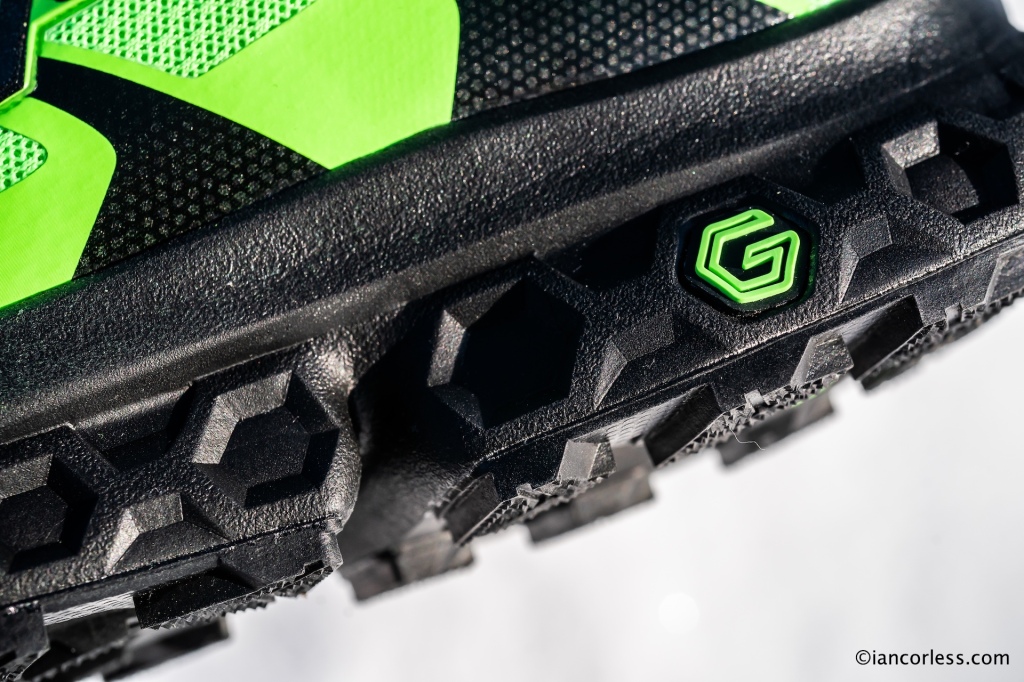
Comfort and stability were very good though. The shoes felt solid, reassured, bulletproof and I had no doubt that they would get the job done and last and last. Ideal for an ultra? The Graphene grip worked great on road and the 4mm lugs caused no hinderance.
TRAIL
Currently my home trails are a mix of snow, ice, rock, single-track and tree routes, so, a perfect place for the TRAILFLY ULTRA G 300 MAX. Gladly, mud is at a relative minimum and what is around, is perfectly manageable for the 4mm G lugs.

In contrast to the road, feel was very similar, particularly on hard single-track. Where a difference could be felt was the interaction with the front of the shoe moving almost independently of the rear when required. This was actually very cool and a great plus of the TRAILFLY ULTRA G 300 MAX.
The rotational flexibility, vertical grooves and the independent heel via Adapter-Flex was noticeable and without doubt, in contrast to some max cushioned shoes, allowed for more control and adaption to the terrain. A huge problem with max cushioned shoes has been the ease and ability to roll an ankle due to the stack height, this is not removed in the TRAILFLY ULTRA G 300 MAX, but it is to a percentage compensated for. Ultimately though, the stack height, for me, has me too far away from the ground.
The shoes size and cushioning in one way could help you bulldoze through terrain, but it didn’t provide any confidence or comfort for me. ‘Dancing’ on technical terrain is difficult in the TRAILFLY ULTRA G 300 MAX due to their size. They are not nimble or light. As an example, when going through a rocky boulder section, the stack height just had me flexing and rotating, my ankles and more importantly knees, where making the compensation for the height off the ground. Of course, flexibility in the ankle and knee is required for all trail running, irrespective of the shoe, but additional stack height and cushioning only exaggerates this.
On snow, the stack height and wider last was great.
Going uphill, foot hold was very good both at the front and the rear, but toe flex was less than desirable almost making me climb with a flatter foot.
Downhill is great, this is when the cushioning and the large heel comes into its own allowing for plenty of protection and a wide base on which to land.
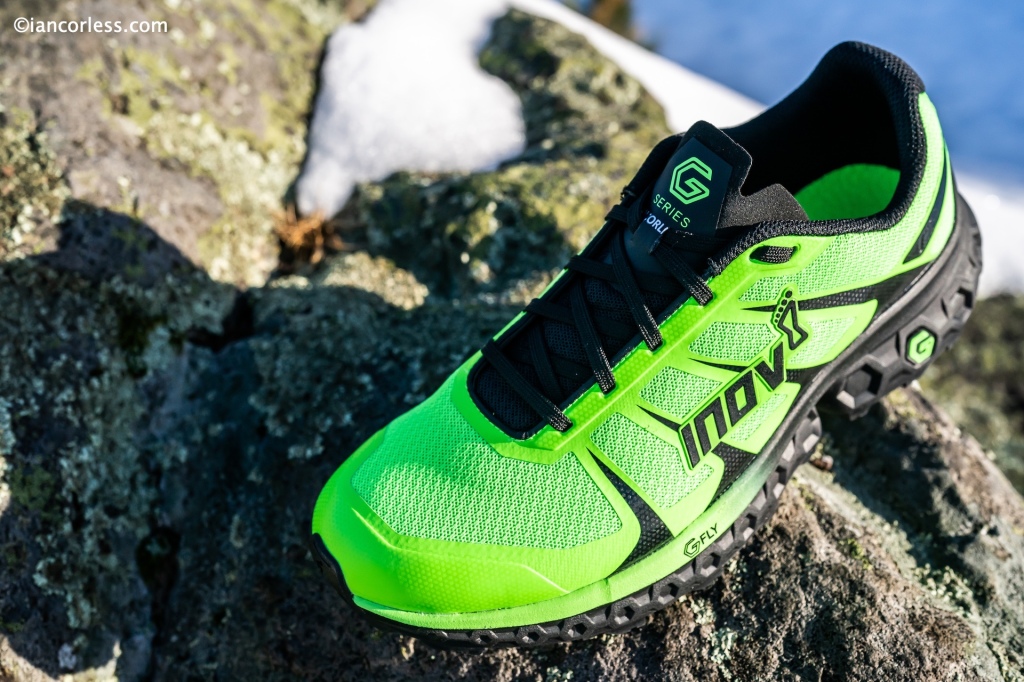
When cruising along on easy trails, the TRAILFLY ULTRA G 300 MAX does allow you to switch off and get on with the job but you are often reminded of the shoes size and weight beneath you and again, I rarely felt that the shoe was giving me anything back… I was working for every mile. Lifeless.
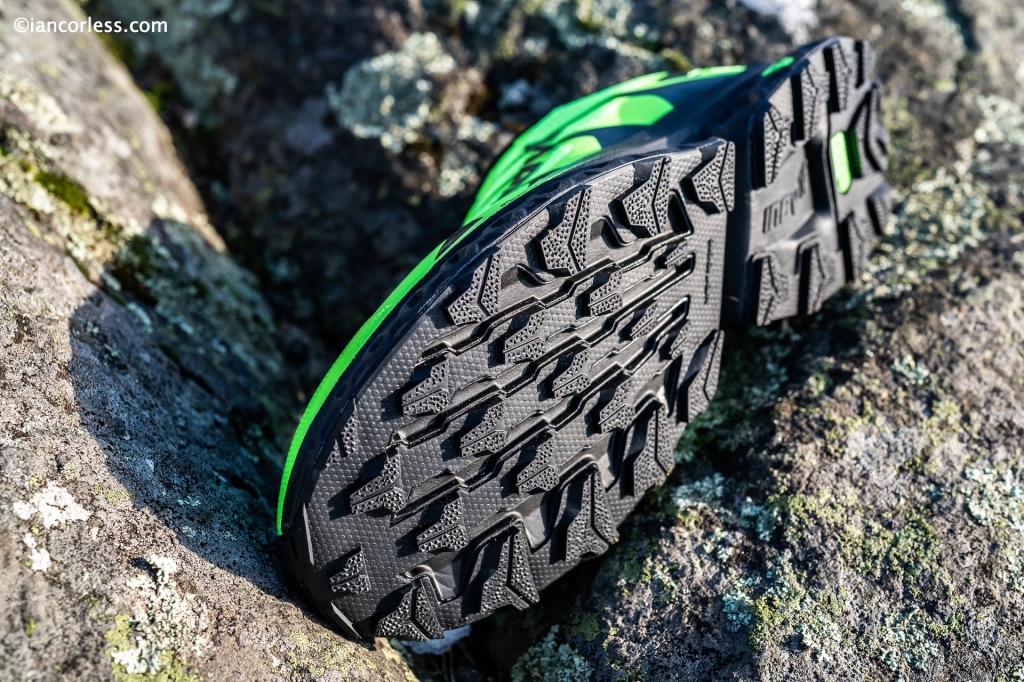
The Graphene grip as we have learnt with the G270 is superb, wet or dry terrain, the only compromise coming in mud – they are not aggressive enough.
SUMMARY
This is a first look at the TRAILFLY ULTRA G 300 MAX and a huge thanks to inov-8 for the opportunity and a personalized shoe with my name on. I have mixed road and trail miles to get an initial feel. I can’t comment on resilience or longevity, that will come in two or three months.
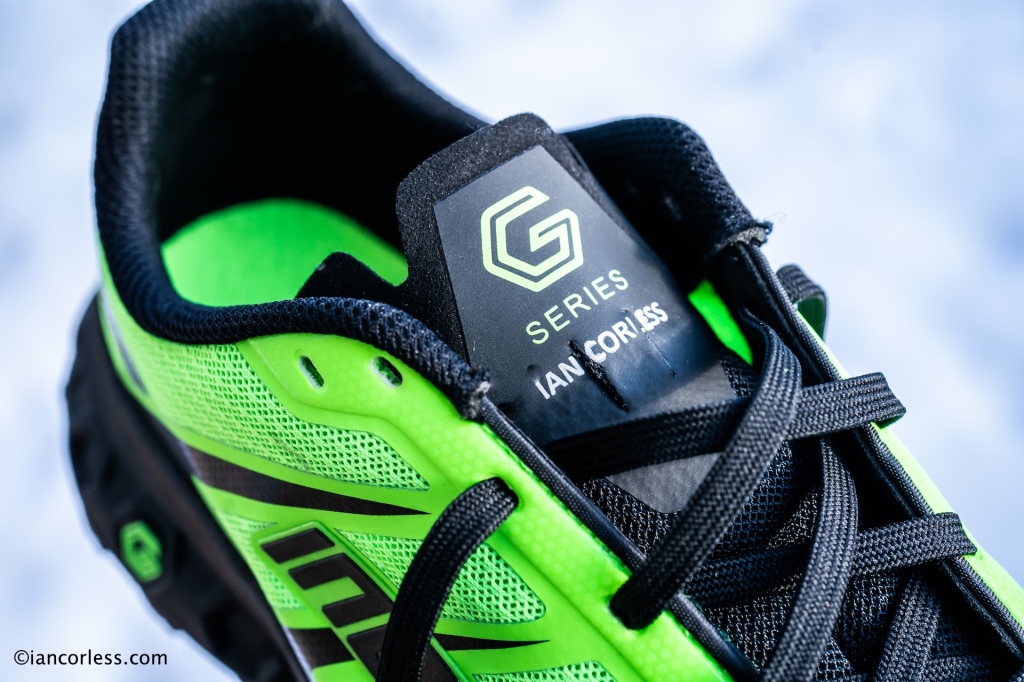
As I said at the beginning, I think this inov-8 shoe will be a Marmite offering. As someone who doesn’t like Marmite, you may well think I was destined not to like the TRAILFLY ULTRA G 300 MAX. That is not the case, I had a really open perspective and I do feel that inov-8 have made some interesting advances and used some unique thought processes in developing the max concept to a new and interesting level. Particularly with the Adapter-Flex. The upper, lacing and foot hold is excellent and arguably a highlight of the shoe.
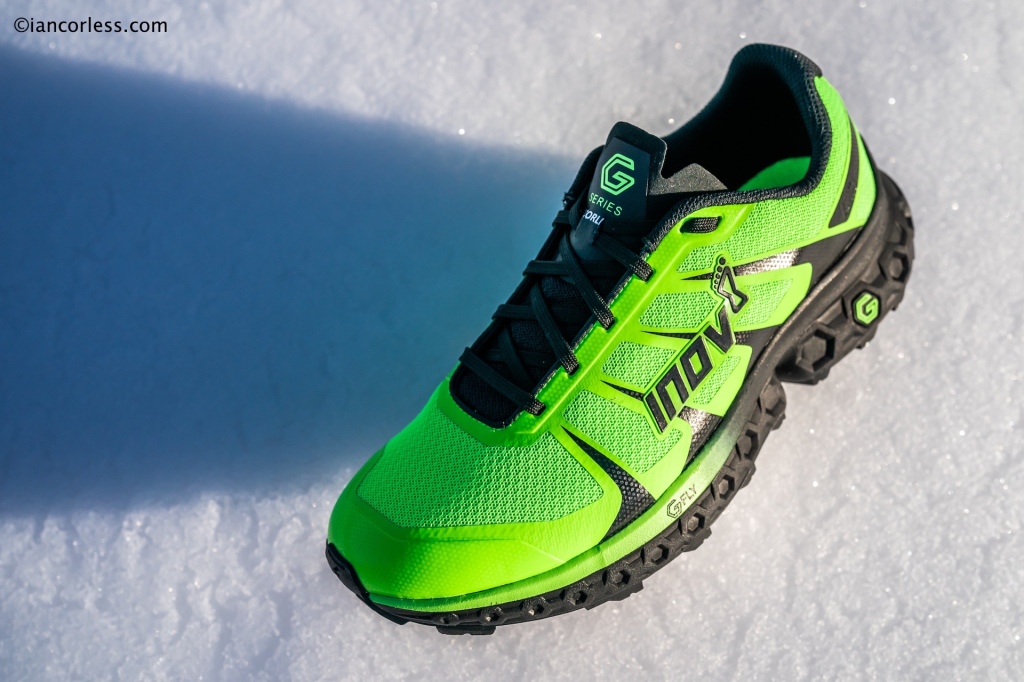
The argument of what cushioning and drop will rage and quite simply, a little of everything is a good thing. It’s one of the reasons I will happily move from say a G270 with zero drop and 12/12 cushioning and then run in a Trail Talon with 8mm drop and 11/19 cushioning. If going to mud, then a Mudclaw with minimal cushioning, 4.5/8.5 and lower drop is ideal.
Ultimately, I choose the correct shoe for the terrain and for how long I am running. Without doubt, if I am running longer, I will choose a shoe with more cushioning and a higher drop.
So, when is too much cushioning, too much? That comes down to the individual. If you have been running in and are used to max cushioned shoes with no injuries, this new shoe from inov-8 may well be just what you have been waiting for. It will have all those trusted features from other max shoes, plus some great new additions and the respected and trusted Graphene grip. And for clarity, I do have two shoes in my regular run rotation of 23/29mm cushioning and 18/26mm cushioning and both of these feel lively, flexible and exciting to use, particularly the 18/26 which seems a wonderful middle ground.
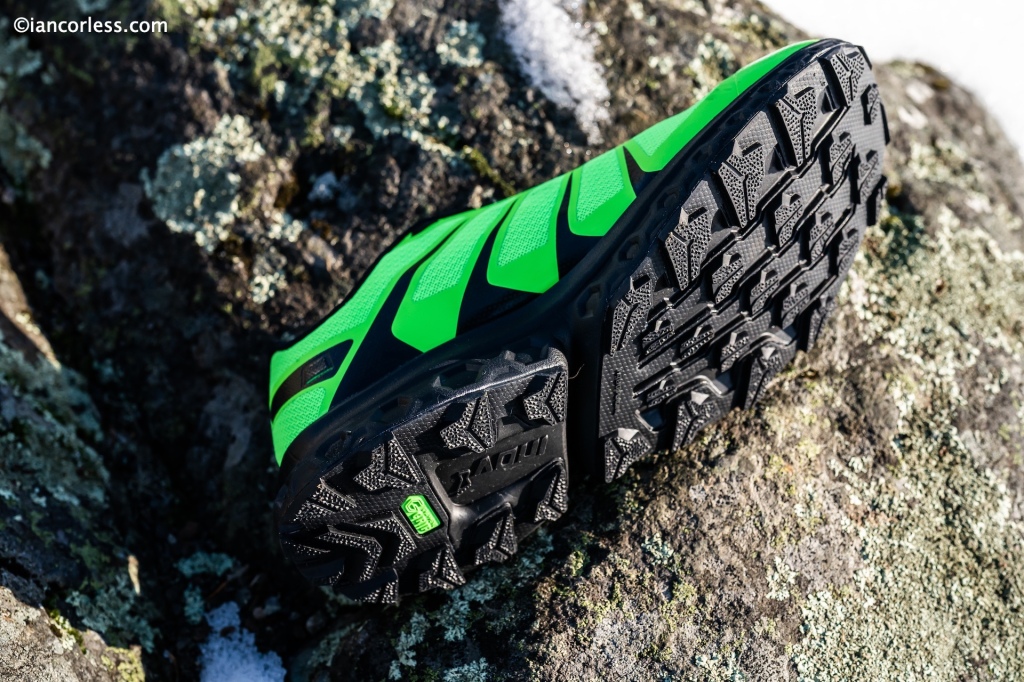
For me though, the TRAILFLY ULTRA G 300 MAX is too much cushioning (too much stack height) and unfortunately, they are too heavy. The expected bounce and flexibility I had hoped for is missing, and I wanted that! Normally I would say that the more one runs, the softer and more flexible a shoe will become… But, the Graphene in the midsole is added to stop this and therefore in 2/3/400 miles, the cushioning should be like day one? By contrast, the Terraultra G270 is full of life, flexible, has a great upper and while not ‘the’ most cushioned shoe out there, it has more than enough cushioning for me. I had hope that the TRAILFLY ULTRA G 300 MAX would be more like the G270… Like a Trail Talon with all the Terraultra G270 features and a 6 or 8mm drop and yes, maybe, just a little more cushioning, say 18/24mm.
Ironically, the TRAILFLY ULTRA G 300 MAX did not ‘feel’ as cushioned as I expected? There are plus points – Graphene outsole, good foot hold but they are horrendously heavy, inflexible and lack any bouncy life. They are lifeless. While it is too early to say, there does seem to be plenty of life in this shoe and the addition of Graphene will only enhance that. This shoe is designed for long days on the trail but I have to say, that for me, the TRAILFLY ULTRA G 300 MAX felt tiring to use and that comes from the weight, the size of the shoe and lack of any life.
Update May 2021:
I have tried and tried but the Trailfly, IMO, is probably the worst shoe inov-8 have made… I keeping reading quotes on inov-8 channels about ‘how great this shoe is’ and I really don’t understand it? I question what shoes were these people running in before ! The Trailfly is heavy, lifeless, dull and I could go on… They bring no joy to running and are actually harder to run in. The plus side is, every other shoe I own now feels light and fast. Hoka have been doing the ‘max’ thing for a long time. Ultimately stick to what you know. The Terraultra G270 by inov is a great shoe, despite the longevity of the upper. I struggle to see how a G270 developed in to a G300 which is not a G300, in my case, it’s a G380 and for those with EU45 or bigger, it is a G400+
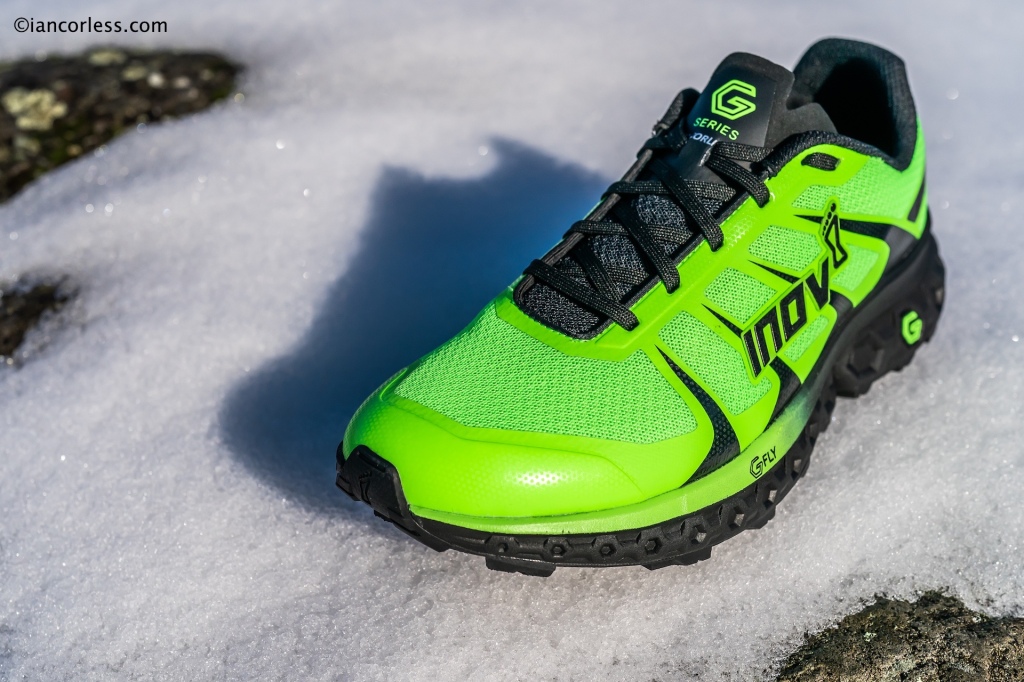
But, inov-8 are excited by this new offering and rightly so, they have gone a long way to develop the max cushioned format, tweak it and adapt it to bring something new. The early Hoka days of 2009 seem a long time ago and for inov-8 to join the party in 2021 signifies how demand has influenced the need to produce a new shoe. While much of the talk in the cushioned world has been about carbon plates, inov-8 have developed Adapter-Flex, Vertical Grooves and the use of Graphene. For that they should be applauded. The TRAILFLY ULTRA G 300 MAX for sure will turn heads but for me, it’s not a good shoe I am afraid. One can only hope V2 is considerably lighter, has more life and is flexible. At £170 they are also very expensive.
As per all my shoe reviews, the shoes were provided for free for impartial testing. This is not a paid review.
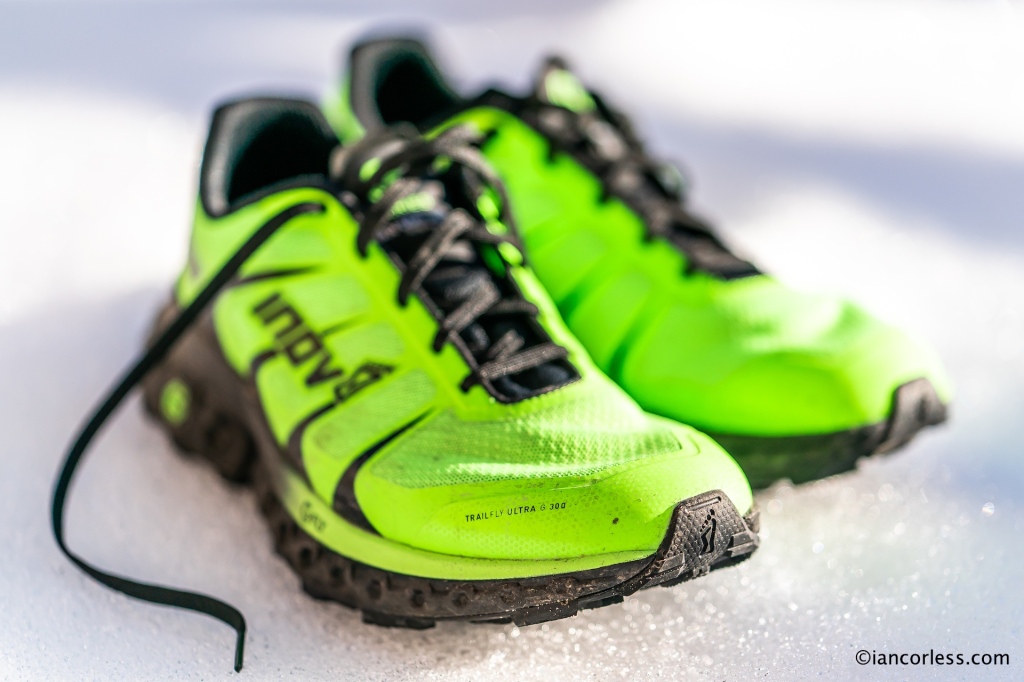
“It will be the first-ever shoe to feature a Graphene-enhanced foam. This, coupled with other new technologies, make it truly unique in the marketplace. It is also our most cushioned shoe ever, but we have maximized our innovation to retain the underfoot agility & flex that inov-8 shoes are renowned for and which other deeply cushioned ultrarunning shoes lack. It’s packed with energy return zip and also boasts Graphene-Grip rubber and the ADAPTER-FIT upper. Designed specifically for ultra and long-distance running over trails, including technical terrain.”
inov-8
Specs:
- Weight: 300g (average weight across size curve) UK9.5 382g / UK7 318g
- Drop: 6mm (heel to forefoot differential)
- Midsole stack height (midsole only): 19mm heel / 25mm
- Full stack height (from bottom of lugs to top of insole): 30.5mm / 36.5mm (24/30 without 6mm foot bed)
- Lug depth: 4mm
- Fit: Grade 5 (inov-8 fit scale in the toe box is 1-5, with 5 being the widest). More details.
- Key technologies: GRAPHENE-GRIP, ADAPTER-FLEX, G-FLY, BOOMERANG, ADAPTER-FIT
RRP £170.00 on Sale from Apr 8 2021.
SUSTAINABILITY – A new inov-8 sustainability strategy, developed in 2020 in partnership with Dr Anne Prahl (an expert at the forefront of sustainable workings and design), will guide every aspect of what we do. Details of the strategy are HERE.
References:
*****
Please support this website. I believe everyone deserves to read quality, independent and factual articles – that’s why this website is open to all. Free press has never been so vital. I hope I can keep providing independent articles with your help. Any contribution, however big or small, is so valuable to help finance regular content. Please support me on Patreon HERE.

Follow on:
Instagram – @iancorlessphotography
Twitter – @talkultra
facebook.com/iancorlessphotography
Web – www.iancorless.com
Web – www.iancorlessphotography.com
Image sales –www.iancorless.photoshelter.com

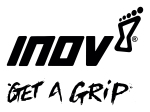
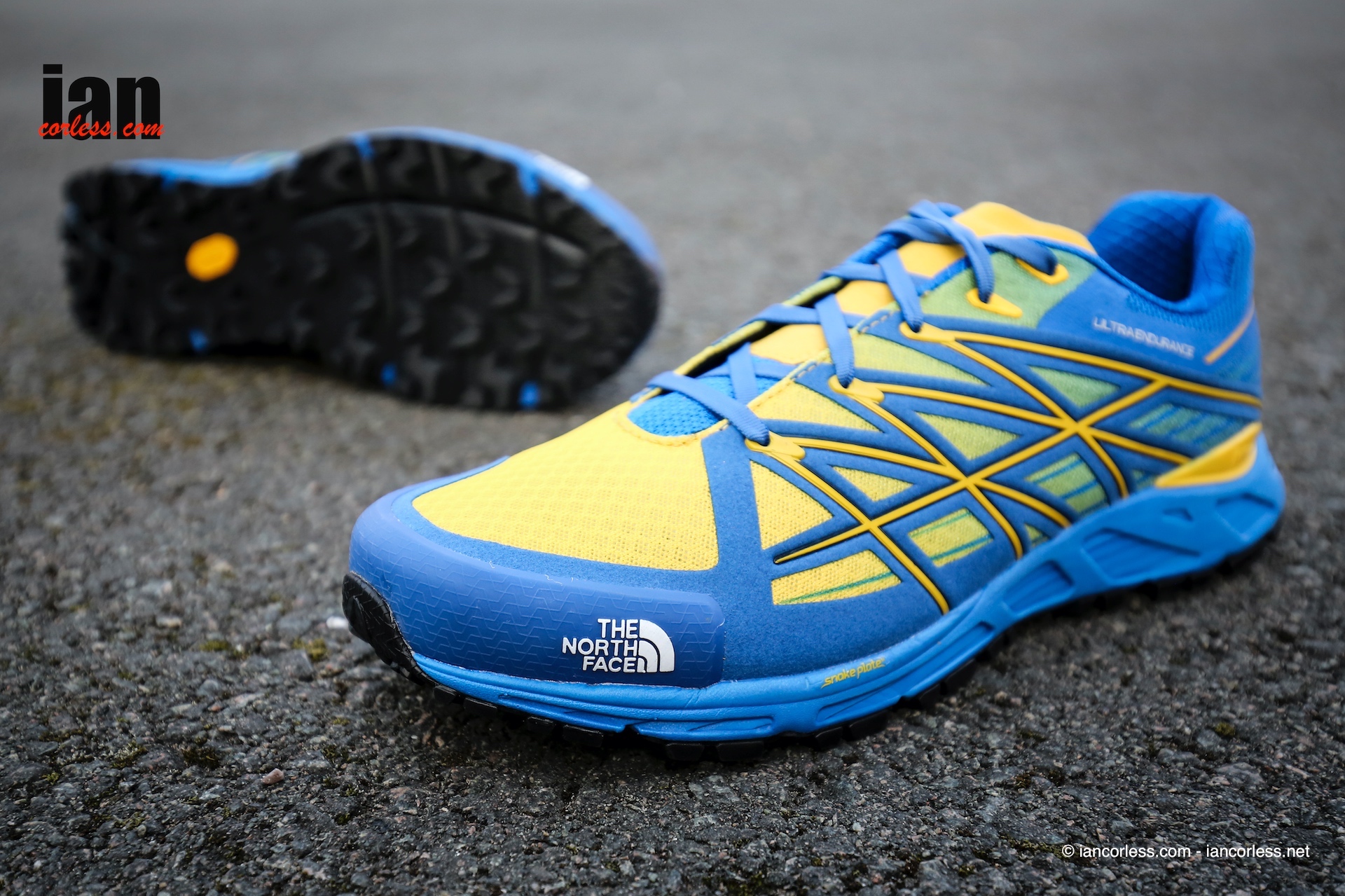 A couple of weeks ago I took a look at the
A couple of weeks ago I took a look at the 